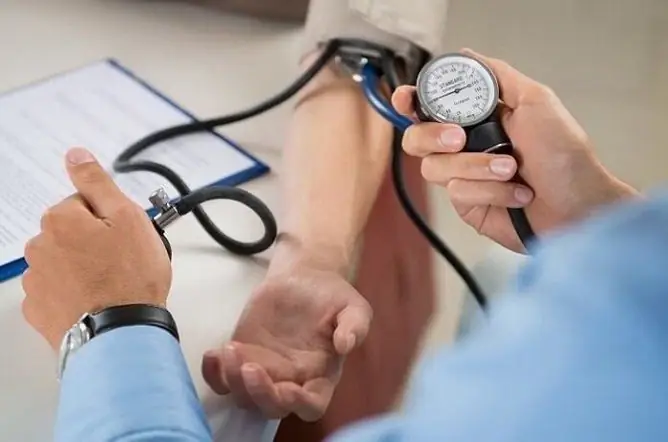- Author Rachel Wainwright [email protected].
- Public 2023-12-15 07:39.
- Last modified 2025-11-02 20:14.
High diastolic pressure: causes, signs, treatment
The content of the article:
- Blood pressure - systolic and diastolic
- What does the increased lower pressure say?
- Why high diastolic pressure is dangerous
- Symptoms of high diastolic pressure
- Diagnostics
- Treating high diastolic blood pressure
- Lifestyle change
- Folk remedies for normalizing high blood pressure
- Video
High diastolic pressure usually indicates a peripheral vascular pathology. Why can it increase in a person without an increase or with a slight increase in systolic, and what to do in such a situation? Let's try to figure it out.

An increase in lower, diastolic blood pressure may be a sign of kidney disease
Blood pressure - systolic and diastolic
Blood pressure (BP) is the force with which blood presses against the walls of the arteries. It is measured in millimeters of mercury (mm Hg) and includes two indicators, which are written through a line, like a fraction. The upper, or systolic, pressure shows the force with which the blood acts on the walls of the blood vessels at the time of systole, that is, contraction of the heart muscle, and the lower, or diastolic, shows the force of peripheral vascular resistance at the time of relaxation of the heart, that is, diastole.
Normally, in a healthy person, diastolic pressure is in the range of 60-90 mm Hg. Art.
The development of arterial hypertension is said in those cases when in three control measurements the arterial pressure was recorded above 140/90 mm Hg. Art. More often, there is a simultaneous increase in both systolic and diastolic pressure, but sometimes there is an increase in only the lower indicator.
What does the increased lower pressure say?
High diastolic blood pressure is usually caused by diseases of the internal organs (kidneys, thyroid gland, adrenal glands, heart). It often happens that high lower pressure becomes one of the first symptoms of these pathologies. Therefore, if it is increased, you should definitely undergo a medical examination.
Diastolic blood pressure is often increased in patients with kidney disease, which is why it is also called "renal", although in fact it may be due to other factors, such as atherosclerosis.
Other causes of high diastolic blood pressure include:
- psychoemotional disorders (depression, manic psychosis, stress);
- abuse of drinks containing caffeine (strong tea, coffee, cola, energy);
- abuse of alcoholic beverages.
Another cause of high lower pressure is fluid retention in the body caused by overeating, eating a lot of salty foods, and smoking.
In pregnant women, high lower pressure is often one of the first symptoms of a formidable complication of pregnancy - OPG-gestosis.
Why high diastolic pressure is dangerous
Increased diastolic pressure with normal systolic pressure indicates the presence of any pathology of the vascular system, leading to difficulty in the normal blood flow through the vessels.
If you do not take measures aimed at normalizing blood pressure, then the internal organs and the brain receive less nutrients and oxygen. This leads to the development of tissue ischemia and hypoxia, increases the risk of myocardial infarction and cerebral stroke. An increase in diastolic pressure in the elderly is especially dangerous, since their blood vessels are significantly altered (atherosclerotic plaques, decreased wall elasticity) and the risk of complications of arterial hypertension is higher.
Symptoms of high diastolic pressure
If the lower pressure rises, the patient develops the following symptoms:
- headache and / or dizziness;
- tachycardia (rapid heart rate);
- feeling short of breath;
- pain in the region of the heart;
- swelling of the limbs;
- noise in ears.
Diagnostics
Increased diastolic pressure is not an independent disease, but develops as a symptom of one or another pathology of internal organs or the endocrine system. Therefore, if an increased indicator of lower blood pressure is repeatedly noted, the patient must undergo a detailed medical examination, including:
- consultations with a therapist, cardiologist, nephrologist and endocrinologist;
- Ultrasound of the abdominal and thyroid organs;
- ECG;
- Echo-KG;
- dopplerography of cerebral vessels;
- clinical (general) analysis of blood and urine;
- determination of the level of thyroid hormones in the blood;
- excretory urography;
- Rehberg's test.
Depending on the results obtained, additional studies of certain organs and systems may be prescribed.

To determine high blood pressure, it is necessary not to measure it once, but three times.
Treating high diastolic blood pressure
How to lower diastolic pressure with normal systolic, because conventional antihypertensive drugs lower both lower and upper blood pressure? You do not need to do this yourself, you need to see a doctor. The main treatment will be to eliminate the primary pathology that led to an increase in lower pressure.
To normalize blood pressure, drugs of the following groups can be used:
- Diuretics (diuretics) - stimulate diuresis, remove excess fluid from the body and eliminate edema.
- Beta blockers - block receptors that are sensitive to adrenaline, causing the blood vessels to relax and the pressure to decrease. The heart rate also decreases. These drugs are contraindicated in patients with chronic obstructive pulmonary disease (COPD).
- Calcium channel blockers (calcium antagonists). They prevent the flow of calcium ions from the intercellular substance into the muscle cells of the blood vessels and the heart. A decrease in the concentration of Ca 2+ in the smooth muscle membrane of the vessels contributes to their expansion and a decrease in blood pressure.
- Angiotensin-converting enzyme (ACE inhibitors) inhibitors. Reduce the concentration of angiotensin in the blood, which leads to a decrease in blood pressure.
- Sympatholytics. They normalize the tone of the blood vessels.
- Antispasmodics. Relaxes muscle cells, including those forming the walls of the arteries.
Taking medications with high diastolic pressure should be in strict accordance with the doctor's prescription. It is unacceptable to independently change the dose of prescribed drugs and the schedule of their administration.
Lifestyle change
Speaking about how to treat high blood pressure, it should be said that lifestyle changes are also of great importance in the complex therapy scheme for this pathology.
First of all, it concerns the diet. Food should be taken 4-5 times a day in small portions. Exclude (or strongly limit) chocolate, coffee, table salt, marinades, fatty and spicy foods from the diet.
The daily menu should include fresh fruits and vegetables, herbs, dried fruits, foods rich in potassium (nuts, cabbage, tomatoes, baked potatoes, dried apricots), magnesium (buckwheat, fish, dairy products, strawberries, bananas) and B vitamins (yeast, liver, meat, pears, apples, oranges). It is advisable to contact a nutritionist to develop a detailed menu that takes into account the energy needs of the body, the general condition of the patient, and the presence of concomitant pathology.
Physical activity. To improve blood circulation, it is necessary to devote sufficient time to physical activity daily. The level of permissible loads is determined by the attending physician, based on the general condition of the patient. Swimming, walking, cycling are preferred. General massage is very useful.

Massage is useful with increased lower pressure, as it helps to normalize vascular tone
Rejection of bad habits. The patient is advised to completely quit smoking. Nicotine contributes to spasm of blood vessels, and therefore an increase in diastolic pressure. It is equally important to give up alcohol abuse (it is permissible to drink no more than 50 ml of cognac or 200 ml of red wine per day).
Normalization of sleep and rest. A night's sleep should last at least 8-9 hours. You should try to go to bed no later than 22 hours. It is important to adhere to the daily routine, alternating work and rest.
Spa treatment. Based on the use of climatic and physical factors that normalize the state of the cardiovascular system and thereby stabilize blood pressure.
Folk remedies for normalizing high blood pressure
If the diastolic pressure slightly increased under the influence of stress, overwork, consumption of not too healthy food, then alternative methods of treatment can be used to reduce it:
- Valerian tincture. Take 2-3 times a day, 5-10 drops. It has a mild sedative effect.
- Infusion of black currant, cedar cones, chokeberry and peony. Mix plant raw materials in equal volumes. Pour two teaspoons of the resulting collection with a glass of cold water and heat over low heat until boiling. Insist 30 minutes, drain. Take a third of a glass 3 times a day half an hour before meals. The infusion contains a large amount of flavonoids, which have a beneficial effect on the state of the vascular wall.
- Lemon juice with honey. Squeeze the juice of half a lemon into a glass, add a tablespoon of honey. Top up with warm water and stir. This drink allows you to quickly reduce the increased diastolic pressure.
Video
We offer for viewing a video on the topic of the article.

Elena Minkina Doctor anesthesiologist-resuscitator About the author
Education: graduated from the Tashkent State Medical Institute, specializing in general medicine in 1991. Repeatedly passed refresher courses.
Work experience: anesthesiologist-resuscitator of the city maternity complex, resuscitator of the hemodialysis department.
Found a mistake in the text? Select it and press Ctrl + Enter.






